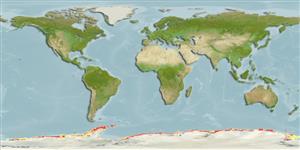>
Perciformes/Notothenioidei (Icefishes) >
Nototheniidae (Cod icefishes) > Trematominae
Etymology: Trematomus: Greek, trematos = hole + Greek, tomo = section, cut (Ref. 45335); newnesi: newnesi named after Sir George Newnes, British newspaper publisher who sponsored Borchgrevinck's Expedition of 1899 (Ref. 11892).
Eponymy: Sir George Newnes (1851–1910) was a British newspaper publisher and Liberal politician. He sponsored the Southern Cross Expedition (1898–1900) to Antarctica. (Ref. 128868), visit book page.
More on author: Boulenger.
Environment: milieu / climate zone / depth range / distribution range
Ecologia
marino demersale; distribuzione batimetrica 0 - 400 m (Ref. 11892). Polar; 60°S - 78°S
Southern Ocean: East Antarctic, Weddell Sea, West coast of Antarctic Peninsula, South Shetland Islands, Elephant Island, South Orkney Islands, Mac Robertson, George V, Queen Mary, Adelie Coasts, Davis Sea and Ross Sea.
Size / Peso / Age
Maturity: Lm ? range ? - ? cm
Max length : 24.5 cm TL maschio/sesso non determinato; (Ref. 58849)
Spine dorsali (totale) : 5 - 8; Raggi dorsali molli (totale) : 29 - 38; Raggi anali molli: 29 - 36.
Found in shallow near shore areas and more commonly in the intertidal zone. Adults feed mainly on amphipods, polychaetes, gastropods, isopods, copepods, and euphausiids (E. superba). Often seen feeding in the water column or at the undersurface of ice.
Dewitt, H.H., P.C. Heemstra and O. Gon, 1990. Nototheniidae. p. 279-331. In O. Gon and P.C. Heemstra (eds.) Fishes of the Southern Ocean. J.L.B. Smith Institute of Ichthyology, Grahamstown, South Africa. (Ref. 5179)
IUCN Red List Status (Ref. 130435: Version 2024-1)
Threat to humans
Harmless
Human uses
Pesca: di nessun interesse
Strumenti
Special reports
Download XML
Fonti Internet
Estimates based on models
Preferred temperature (Ref.
123201): -1.8 - -0.4, mean -1.4 °C (based on 237 cells).
Phylogenetic diversity index (Ref.
82804): PD
50 = 0.5005 [Uniqueness, from 0.5 = low to 2.0 = high].
Bayesian length-weight: a=0.00537 (0.00279 - 0.01033), b=3.24 (3.08 - 3.40), in cm total length, based on LWR estimates for this Genus-body shape (Ref.
93245).
Trophic level (Ref.
69278): 3.2 ±0.2 se; based on diet studies.
Generation time: 3.1 ( na - na) years. Estimated as median ln(3)/K based on 2
growth studies.
Resilienza (Ref.
120179): Medio, tempo minimo di raddoppiamento della popolazione 1.4 - 4.4 anni (Fec = 2,300-12,200).
Fishing Vulnerability (Ref.
59153): Low to moderate vulnerability (28 of 100).
